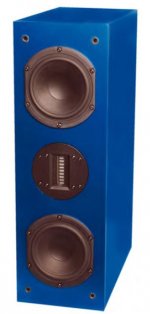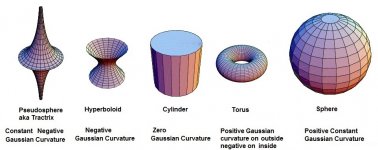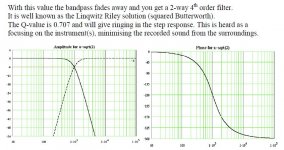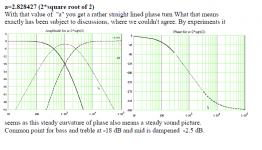Hi, I'm new here so this will be my first post. Keep in mind that I do not have an engineering background, but I'm taking an electronics course atm, and have built some kit loudspeakers and subwoofers in the past.
I read an interesting piece about the Bang & Olufsen phase link principle:
B&O Tech: Uni-Phase Loudspeakers – earfluff and eyecandy
I'm sure there is a lot more to it than this, but it seems such an excellent use for a dome midrange to bridge the gap between a tweeter and a woofer in a two way with second order filters? If not, what is wrong with it? To me it seems you could get excellent dispersion, phase characteristics etc this way? There has to be SOME reason why this appears not be used a whole lot anymore? I remember a friend of my mom having one of those Beovox 70 speakers and I thought they were excellent, relatively speaking, even though they were allready quite old when I heard them (not high end, obviously).
Greatful for any thoughts on the subject.
I read an interesting piece about the Bang & Olufsen phase link principle:
B&O Tech: Uni-Phase Loudspeakers – earfluff and eyecandy
I'm sure there is a lot more to it than this, but it seems such an excellent use for a dome midrange to bridge the gap between a tweeter and a woofer in a two way with second order filters? If not, what is wrong with it? To me it seems you could get excellent dispersion, phase characteristics etc this way? There has to be SOME reason why this appears not be used a whole lot anymore? I remember a friend of my mom having one of those Beovox 70 speakers and I thought they were excellent, relatively speaking, even though they were allready quite old when I heard them (not high end, obviously).
Greatful for any thoughts on the subject.
It's based on cancelling and the midrange must be a very good widerange driver actually, given only 1st order acoustic target slopes for the midrange! Distortion and dispersion pattern will suffer accordingly. While a linear-phase crossover has its merits, this implenentation is very demanding and wasteful on the drivers, not fully exploiting their true virtues. That's why it is not widely used.
Much better is the Duelund crossover which looks somewhat simlilar, again a filler driver in use. But this time all drivers are always in phase and the slopes on the midrange are second order, much more managable yet still tackling the midrange driver low frequency excursion capabilites which limits its usefulness. Total phase response is that of 4rd order two-way. Phase can always be corrected by pre-distorting the input signal that "unwraps" the total phase contribution of the crossover to zero, via DSP.
But even without that correction I find phase-matched multiway crossovers like the Duelund overall better sounding than speakers where the total phase transitions all the time between the driver's individual phase contributions. While "speedy", the latter sound less coherent to me, somewhat bloated but instable soundstage perception. The phase-matched speakers have more a pin-point sharp see-through quality...
Much better is the Duelund crossover which looks somewhat simlilar, again a filler driver in use. But this time all drivers are always in phase and the slopes on the midrange are second order, much more managable yet still tackling the midrange driver low frequency excursion capabilites which limits its usefulness. Total phase response is that of 4rd order two-way. Phase can always be corrected by pre-distorting the input signal that "unwraps" the total phase contribution of the crossover to zero, via DSP.
But even without that correction I find phase-matched multiway crossovers like the Duelund overall better sounding than speakers where the total phase transitions all the time between the driver's individual phase contributions. While "speedy", the latter sound less coherent to me, somewhat bloated but instable soundstage perception. The phase-matched speakers have more a pin-point sharp see-through quality...
crazyspeakerman, you can't escape complexity in loudspeaker engineering! And mathematics. It's a journey that can entertain you for a lifetme. 
I would have to totally agree with KTSR that shallow slopes on a dome midrange are going to be poor for distortion artefacts. Never mind the difficulty of implemantation of a driver that has a natural second order rolloff at extremes.
Troels Gravesen shows considerable insight with his take on the dome midrange concept: SP38/13
This must be a cleaner sound than the B&O Uni-Phase design. Less distortion.
Function of a complex variable is actually about 200 year old algebra. Augustin-Louis Cauchy did all this. Steen Duelund and John Kreskovsky have continued the application to speakers: Duelund and Beyond
TBH, we are all bottom feeders with this 2D Clifford algebra. The smart people have moved way beyond into 4D: Ubiquitous octonions | plus.maths.org and 8D: The Octonion Math That Could Underpin Physics | Quanta Magazine
These higher Clifford algebras have far more complexity and possibilities and symettries in them. And as Emmy Noether discovered and proved, where you have a symettry, you have a conservation law. If my eyes didn't deceive me, Quarks and Neutrinos naturally drop out of Octonion algebra!
Even the relative masses of the Electron, Muon and Tauon comes from properties of algebra: The Koide formula explained by flavour mixing in a Weyl 2-spinor, Schroedinger ‘Zitterbewegung’ lepton – Quantum field theory
My own speaker designs incorporate a lot of algebra and theory:

https://www.diyaudio.com/forums/multi-way/203461-restoring-monitor-audio-r300-bookshelf-speakers-4.html#post5594768
Some random images below. All is symmettry!
I would have to totally agree with KTSR that shallow slopes on a dome midrange are going to be poor for distortion artefacts. Never mind the difficulty of implemantation of a driver that has a natural second order rolloff at extremes.
Troels Gravesen shows considerable insight with his take on the dome midrange concept: SP38/13
This must be a cleaner sound than the B&O Uni-Phase design. Less distortion.
Function of a complex variable is actually about 200 year old algebra. Augustin-Louis Cauchy did all this. Steen Duelund and John Kreskovsky have continued the application to speakers: Duelund and Beyond
TBH, we are all bottom feeders with this 2D Clifford algebra. The smart people have moved way beyond into 4D: Ubiquitous octonions | plus.maths.org and 8D: The Octonion Math That Could Underpin Physics | Quanta Magazine
These higher Clifford algebras have far more complexity and possibilities and symettries in them. And as Emmy Noether discovered and proved, where you have a symettry, you have a conservation law. If my eyes didn't deceive me, Quarks and Neutrinos naturally drop out of Octonion algebra!
Even the relative masses of the Electron, Muon and Tauon comes from properties of algebra: The Koide formula explained by flavour mixing in a Weyl 2-spinor, Schroedinger ‘Zitterbewegung’ lepton – Quantum field theory
My own speaker designs incorporate a lot of algebra and theory:
https://www.diyaudio.com/forums/multi-way/203461-restoring-monitor-audio-r300-bookshelf-speakers-4.html#post5594768
Some random images below. All is symmettry!
Attachments
Thanks to all that replied. I have a long term goal of developing my own 3 or 4 way loudspeaker, because I'm getting tired of messing with subwoofers and even more so with the "suckout" of the cone/dome transition of all my speakers (most of which are two way). I really want a more homegenous sound that is more stable in it's phase and dispersion properties as I have a rather live room and would hate to make my living room into a sound studio, just to get proper stereo imaging and relaxed laid back sound. My hope is that such a system would not sound harsh and strained, but rather more laid back as the drivers would not be pushed to their limits. Upon reflection I see that I have to use a cone midrange for the phase link unit, should I decide to go that route.
I'm torn between choosing a pure 4 way with possibly dome midrange or possibly a 3(4) using a cone for a mid but with a phase link driver between the mid and tweet. The uniphase or phaselink was fairly easy to understand but the Duelund seemed a lot more complicated. I'm not sure I fully understood the explanation/math of how it even worked and I have a feeling the simulations/measurements would be a nightmare to troubleshoot. I think maybe I'd have to be a bit less ambitious, but a phase link seems doable.
I'll keep reading, and start on the speaker when I have a better grasp on the theory.
I'm torn between choosing a pure 4 way with possibly dome midrange or possibly a 3(4) using a cone for a mid but with a phase link driver between the mid and tweet. The uniphase or phaselink was fairly easy to understand but the Duelund seemed a lot more complicated. I'm not sure I fully understood the explanation/math of how it even worked and I have a feeling the simulations/measurements would be a nightmare to troubleshoot. I think maybe I'd have to be a bit less ambitious, but a phase link seems doable.
I'll keep reading, and start on the speaker when I have a better grasp on the theory.
I thought I'd chime in with a brief description of my style of work-flow with XOs and filtering. I might do a bigger write-up some day, but for now:
Rather than going straight into microphone measurements, I usually get a music keyboard ready (preferably with a pitch-bend knob) and connect it to the PC with a soft-synth and filtering software. It helps to have a calculator handy, remind yourself how to calculate semitones in equal temperament, and remember that A above middle C is 440Hz.
I manually produce some sine waves at various frequencies, usually starting at low frequencies and going up. It's amazing what you might find just by tinkering and training your ears.
For instance, I've often found a dominant spike around 40Hz, which required a generous 12dB notch with a Q of about 3 (and that's with a 10" woofer in a sealed box). Homing in on the centre frequency is easy, but finding the depth and Q requires a bit of trial and error. Other spikes can be found, but the first one -- the one that your ears lead you to -- can fix most of the subjective "room thud" with just one filter.
Based on that, in future amplifier designs, I intend to hard-wire an adjustable notch with the pre-amp. I don't trust digital filters enough for that purpose yet -- the high noise levels suggest that software developers sometimes forget to use doubles instead of single-precision floats for their IIR algorithms.
Going up in frequency, 150~300 Hz, this is where it gets tricky. Depending on box dimensions, the air inside will start to produce its first standing waves, but 1/4 wavelength is in the order of 25-50cm, which is very difficult to control. By carefully doing slow, manual sine sweeps, it may be possible to find narrow frequency bands where the box starts to rattle (even if common sense would suggest that it's extremely solid) and/or the woofer starts to severely distort. AFAIK, the sound pressure inside the box grows to extreme levels, and in order to regulate the voltage, the amplifier has to supply a higher and higher (and less linear) back-emf current. Since the (external) SPL is mostly unaffected, it doesn't show up on a frequency plot, except perhaps for a tiny blip. I've tried using high-Q notches, but those can easily go out of tune with environmental changes.
It's a pain because to properly fix it you need to change the hardware: either go full open-baffle, or at least reduce the box SPL with a resistive vent, or significantly increase box volume. Electronic/software solutions seem to go full circle on this issue, so it never really goes away. For instance, if you increase the output impedance, or change to a current amplifier, box SPL leaks out through the speaker cone because of the reduced damping. While the reduced in-box pressure could reduce THD and IM distortion, it also alters the frequency response. And any attempt to fix that with pre-correction (EQ, active filters, digital filters, etc), will simply return to the high-SPL and distortion conditions described above.
Anyway, it's nice to be able to play around with the crossover points. I have a 3-way (10" + 7" + 1") where the bass is sealed, and the mid-woofer has resistive vents and a mechanical roll-off approaching 200Hz. When playing sine waves, the character of the sound is a bit different between the bass and mid. The bass speaker fills the room, while the mid-woofer can fade with farther listening positions, so the "correct" XO and EQ settings will be sensitive to the layout and purpose of your system. It would be nice to also play around with phase correction, but someone find me nice Linux/Jack-aware app to do it with! Most of the EQ software out there just falls short.
Rather than going straight into microphone measurements, I usually get a music keyboard ready (preferably with a pitch-bend knob) and connect it to the PC with a soft-synth and filtering software. It helps to have a calculator handy, remind yourself how to calculate semitones in equal temperament, and remember that A above middle C is 440Hz.
I manually produce some sine waves at various frequencies, usually starting at low frequencies and going up. It's amazing what you might find just by tinkering and training your ears.
For instance, I've often found a dominant spike around 40Hz, which required a generous 12dB notch with a Q of about 3 (and that's with a 10" woofer in a sealed box). Homing in on the centre frequency is easy, but finding the depth and Q requires a bit of trial and error. Other spikes can be found, but the first one -- the one that your ears lead you to -- can fix most of the subjective "room thud" with just one filter.
Based on that, in future amplifier designs, I intend to hard-wire an adjustable notch with the pre-amp. I don't trust digital filters enough for that purpose yet -- the high noise levels suggest that software developers sometimes forget to use doubles instead of single-precision floats for their IIR algorithms.
Going up in frequency, 150~300 Hz, this is where it gets tricky. Depending on box dimensions, the air inside will start to produce its first standing waves, but 1/4 wavelength is in the order of 25-50cm, which is very difficult to control. By carefully doing slow, manual sine sweeps, it may be possible to find narrow frequency bands where the box starts to rattle (even if common sense would suggest that it's extremely solid) and/or the woofer starts to severely distort. AFAIK, the sound pressure inside the box grows to extreme levels, and in order to regulate the voltage, the amplifier has to supply a higher and higher (and less linear) back-emf current. Since the (external) SPL is mostly unaffected, it doesn't show up on a frequency plot, except perhaps for a tiny blip. I've tried using high-Q notches, but those can easily go out of tune with environmental changes.
It's a pain because to properly fix it you need to change the hardware: either go full open-baffle, or at least reduce the box SPL with a resistive vent, or significantly increase box volume. Electronic/software solutions seem to go full circle on this issue, so it never really goes away. For instance, if you increase the output impedance, or change to a current amplifier, box SPL leaks out through the speaker cone because of the reduced damping. While the reduced in-box pressure could reduce THD and IM distortion, it also alters the frequency response. And any attempt to fix that with pre-correction (EQ, active filters, digital filters, etc), will simply return to the high-SPL and distortion conditions described above.
Anyway, it's nice to be able to play around with the crossover points. I have a 3-way (10" + 7" + 1") where the bass is sealed, and the mid-woofer has resistive vents and a mechanical roll-off approaching 200Hz. When playing sine waves, the character of the sound is a bit different between the bass and mid. The bass speaker fills the room, while the mid-woofer can fade with farther listening positions, so the "correct" XO and EQ settings will be sensitive to the layout and purpose of your system. It would be nice to also play around with phase correction, but someone find me nice Linux/Jack-aware app to do it with! Most of the EQ software out there just falls short.
I have been guilty of getting very interesting in a certain design approach that is new to me and thinking it will solve certain shortcomings that it may not in fact be able to solve. Ordinarily the limitations of a two way are mostly 1. Dynamic limits 2.limited low frequency. Not typically a suck out between the two drivers. Be careful not to assume that a midrange will always make things better. Just a thought from my many years and hard lessons / dollars spent.
If you can get to an audio show and listen to a bunch of different stuff, it's eye opening. Also in a live room, look at directivity as being perhaps the most important aspect of the design. ie horns
Just my 2 cents, Craig
If you can get to an audio show and listen to a bunch of different stuff, it's eye opening. Also in a live room, look at directivity as being perhaps the most important aspect of the design. ie horns
Just my 2 cents, Craig
- Status
- This old topic is closed. If you want to reopen this topic, contact a moderator using the "Report Post" button.



